Autism spectrum disorder: Highlights from the 2019 Canadian health survey on children and youth
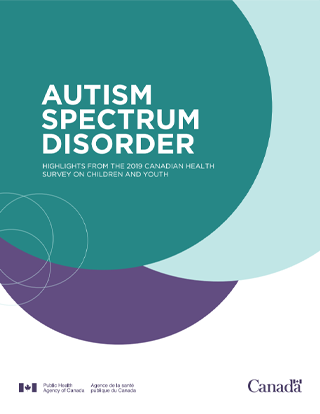
Download the alternative format
(PDF format, 1.13 KB, 31 pages)
Organization: Public Health Agency of Canada
Published: February 2022
Table of contents
- Executive summary
- Introduction
- Key findings
- Prevalence of autism spectrum disorder
- Prevalence by province/territory
- Prevalence by household income
- Prevalence by other sociodemographic factors
- Age at diagnosis
- Life satisfaction, happiness and stress
- General and mental health
- Co-occurring long-term health conditions
- Functional difficulties
- School experiences
- Closing remarks
- Resources
- COVID-19 statement
- About the data
- Definition of terms
- Acknowledgements
- References
Executive summary
Purpose of this report
This report provides an overview of Canadian children and youth with diagnosed autism spectrum disorder (ASD) using data from the 2019 Canadian Health Survey on Children and Youth (CHSCY). It includes information on prevalence, age at diagnosis, health status, co-occurring long-term health conditions, functional difficulties and school experiences. This information will be used to build the evidence base required to inform public health action aimed to improve the health and well-being of Canadian children and youth with ASD and their caregivers.
About the data
The 2019 CHSCY is a national, cross-sectional survey that provides health-related information on Canadian children and youth. The survey is representative of the Canadian population aged 1 to 17 years as of January 31, 2019, living in private dwellings in Canada's ten provinces and three territories. Excluded from the survey's coverage are children and youth living on First Nation reserves and other Aboriginal settlements in the provinces, children and youth living in foster homes and in institutions.
Note: Prevalence estimates in this report differ from those in the Public Health Agency of Canada's 2018 National Autism Spectrum Disorder Surveillance System report due to differences in the year data were collected, age groups included, geographical coverage and methods/criteria used to identify ASD.
Key findings
According to the 2019 CHSCY, 1 in 50 (or 2.0%) Canadian children and youth aged 1 to 17 years were diagnosed with ASD. Of these individuals:
- males were diagnosed approximately four times more frequently than females
- just over half (53.7%) were diagnosed before the age of five
- fewer, compared to those without ASD, reported having optimal general health (59.3% vs. 89.5%) and optimal mental health (39.0% vs. 84.1%)
- over two-thirds (68.7%) had another long-term health condition, with attention deficit disorder/attention deficit hyperactivity disorder, learning disability/disorder and anxiety disorder being the most common
- close to three-quarters (73.3%) of those aged 2 to 17 years had difficulty in at least one functional domain, with communication, accepting change and making friends being among the most common
- more than three-quarters (78.1%) of those attending school had special education needs
Language statement
Throughout the autism community, it is recognized that preferences differ on the use of person-first ('children and youth with ASD') vs. identity-first language ('autistic children and youth'). This report uses person-first language ('children and youth with ASD').
Introduction
Autism spectrum disorder (ASD) is a neurodevelopmental disorder that can include impairments in speech, non-verbal communication and social interactions combined with restricted and repetitive behaviours, interests or activities.Footnote 1 Each person with ASD is unique, and the term "spectrum" refers to the wide variation in strengths and challenges reflected among those with the disorder.
This report profiles Canadian children and youth aged 1 to 17 years with diagnosed ASD using data from the 2019 Canadian Health Survey on Children and Youth (CHSCY) (see Data Source for more information). It includes information on prevalence, age at diagnosis, health status, co-occurring long-term health conditions, functional difficulties and school experiences. Children and youth were identified as having ASD if their person most knowledgeable (PMK) responded "yes" to the question: "Has this child been diagnosed with any of the following long-term conditions? – Autism spectrum disorder, also known as autism, autistic disorder, Asperger's disorder or pervasive developmental disorder".Footnote 2
Note: Prevalence estimates from the 2019 Canadian Health Survey on Children and Youth in this report differ from those in the Public Health Agency of Canada's 2018 National Autism Spectrum Disorder Surveillance System report due to differences in the year data were collected (2019 vs. 2015), age groups included (1 to 17 vs. 5 to 17 years), geographical coverage (all provinces and territories vs. six provinces and one territory) and methods/criteria used to identify ASD (reported ASD diagnosis from the person most knowledgeable vs. ASD diagnosis from education, health and social services data sources).
Key findings
Prevalence of autism spectrum disorder
According to the 2019 CHSCY, 1 in 50 (or 2.0%) Canadian children and youth aged 1 to 17 years were diagnosed with ASD
- About 1 in 50 or 2.0% [95% confidence interval: 1.8, 2.2] of Canadian children and youth aged 1 to 17 years were diagnosed with ASD (Figure 1).
- The highest prevalence of ASD was among those aged 5 to 11 years (1 in 40 or 2.5% [2.2, 2.8]), followed by those aged 12 to 17 years (1 in 53 or 1.9% [1.6, 2.2]) and those aged 1 to 4 years (1 in 91 or 1.1% [0.9, 1.4]). The prevalence of ASD in those aged 1 to 4 years was statistically significantly lower than the two older age groups.
- Males were diagnosed with ASD approximately four times more frequently than females; 1 in 32 males (3.1% [2.8, 3.4]) and 1 in 125 females (0.8% [0.7, 1.0]). This difference was statistically significant.
- Males had a statistically significantly higher prevalence of ASD than females overall and in all age groups, with the largest relative difference being among those aged 5 to 11 years.
- Reporting on gender diversity in this population was not possible due to small sample size.
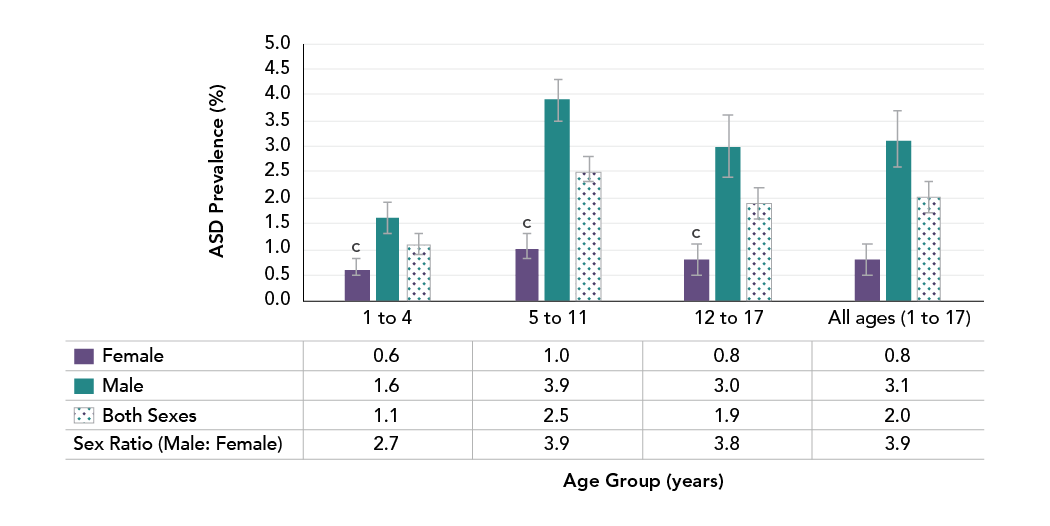
C High sampling variability (coefficient of variation between 15.0% and 25.0%).
Notes: ASD = autism spectrum disorder. The 95% confidence interval shows an estimated range of values that is likely to include the true prevalence 19 times out of 20.
Source: Public Health Agency of Canada, using data from the 2019 Canadian Health Survey on Children and Youth.
Figure 1 Text Description
| ASD Prevalence, % [95% CI] | ||||
|---|---|---|---|---|
| Age group (years) | ||||
| Sex | 1 to 4 | 5 to 11 | 12 to 17 | All ages (1 to 17) |
| Female | 0.6C [0.4, 0.9] | 1.0C [0.7, 1.3] | 0.8C [0.5, 1.1] | 0.8 [0.7, 1.0] |
| Male | 1.6 [1.2, 2.0] | 3.9 [3.4, 4.5] | 3.0 [2.5, 3.6] | 3.1 [2.8, 3.4] |
| Both Sexes | 1.1 [0.9, 1.4] | 2.5 [2.2, 2.8] | 1.9 [1.6, 2.2] | 2.0 [1.8, 2.2] |
| Sex Ratio (Male: Female) |
2.7 | 3.9 | 3.8 | 3.9 |
C High sampling variability (coefficient of variation between 15.0% and 25.0%). Notes: ASD = autism spectrum disorder. CI = confidence interval. The 95% confidence interval shows an estimated range of values that is likely to include the true prevalence 19 times out of 20. Source: Public Health Agency of Canada, using data from the 2019 Canadian Health Survey on Children and Youth. |
||||
Prevalence by province/territory
Prevalence of ASD in children and youth varied by province
- The crude prevalence of ASD varied across Canada, ranging from 0.8%Footnote * [0.3, 1.4] in Saskatchewan to 4.1%Footnote † [2.6, 5.5] in New Brunswick (Figure 2).
- The age-standardized prevalence was statistically significantly lower than the national average in Saskatchewan (2.1 times) and statistically significantly higher in New Brunswick (2.3 times). Whereas the age-standardized prevalence in the remaining eight provinces did not statistically significantly differ from Canada as a whole.
- The prevalence of ASD for the territories could not be reported due to the small sample size.
Figure 2: Crude prevalence of ASD among children and youth aged 1 to 17 years, by province/territory, Canada, 2019
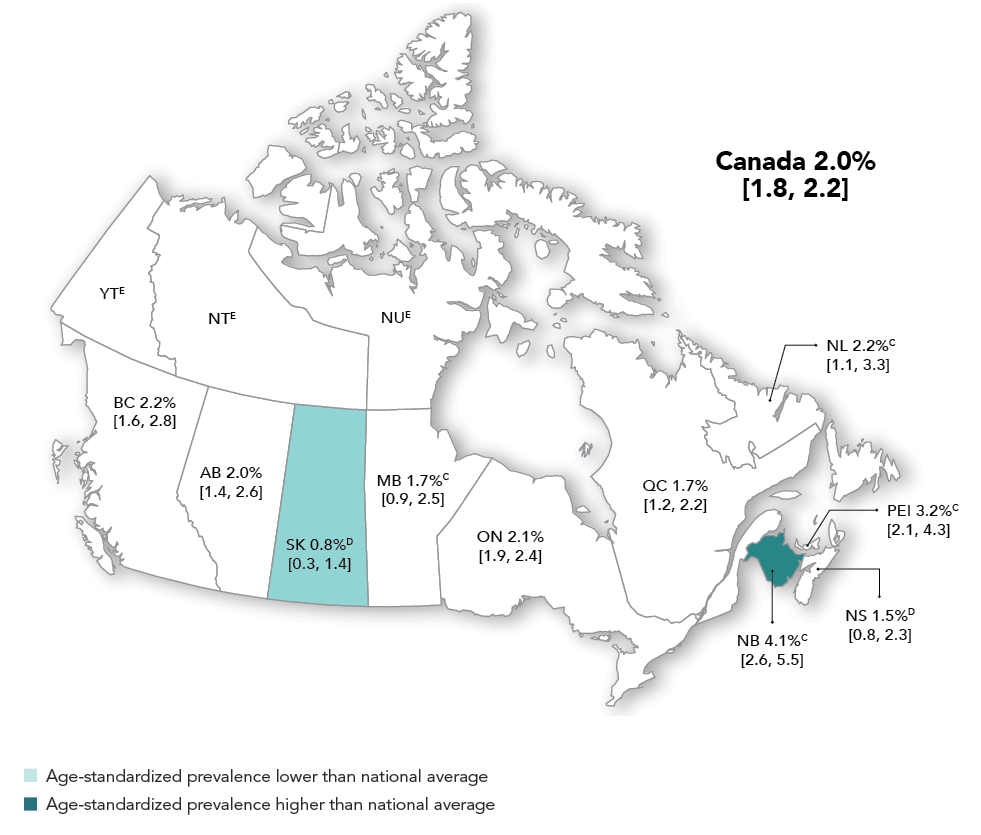
C High sampling variability (coefficient of variation between 15.0% and 25.0%).
D High sampling variability (coefficient of variation between 25.0% and 35.0%).
E Unreliable estimate due to high sampling variability (coefficient of variation over 35%).
Notes: ASD = autism spectrum disorder. YK = Yukon. NT = Northwest Territories. NU = Nunavut. BC = British Columbia. AB = Alberta. SK = Saskatchewan. MB = Manitoba. ON = Ontario. QC = Quebec. NB = New Brunswick. NS = Nova Scotia. PEI = Prince Edward Island. NL = Newfoundland and Labrador. The 95% confidence interval (included in brackets) shows an estimated range of values that is likely to include the true prevalence 19 times out of 20. The 2011 Canadian Census population was used to age-standardize prevalence using 5-year age groups.
Source: Public Health Agency of Canada, using data from the 2019 Canadian Health Survey on Children and Youth and the 2011 Canadian Census population for age-standardization.
Figure 2 Text Description
This figure shows a map of Canada, with the crude prevalence of ASD among children and youth aged 1 to 17 years displayed for each province and territory, and the overall Canadian prevalence displayed in the top right corner. The crude prevalence by province/territory included in the map are summarized in the table below. The prevalence of ASD could not be reported for the territories due to small case counts.
Provinces and territories are shaded to indicate if the age-standardized prevalence of ASD was lower or higher than the national average. Saskatchewan is shaded light blue to indicate that the age-standardized prevalence was lower than the national average. New Brunswick is shaded dark blue to indicate that the age-standardized prevalence was higher than the national average. The remaining eight provinces are not shaded to indicate that the age-standardized prevalence was not significantly different from the national average. The 2011 Canadian Census population was used to age-standardize prevalence using 5-year age groups.
| Province/Territory | Crude ASD Prevalence, % [95% CI] |
|---|---|
| British Columbia | 2.2 [1.6, 2.8] |
| Alberta | 2.0 [1.4, 2.6] |
| Saskatchewan | 0.8D [0.3, 1.4] |
| Manitoba | 1.7C [0.9, 2.5] |
| Ontario | 2.1 [1.9, 2.4] |
| Quebec | 1.7 [1.2, 2.2] |
| New Brunswick | 4.1C [2.6, 5.5] |
| Nova Scotia | 1.5D [0.8, 2.3] |
| Prince Edward Island | 3.2C [2.1, 4.3] |
| Newfoundland and Labrador | 2.2C [1.1, 3.3] |
| Yukon | E |
| Northwest Territories | E |
| Nunavut | E |
| Canada | 2.0 [1.8, 2.2] |
C High sampling variability (coefficient of variation between 15.0% and 25.0%). D High sampling variability (coefficient of variation between 25.0% and 35.0%). E Unreliable estimate due to high sampling variability (coefficient of variation over 35%). Notes: ASD = autism spectrum disorder. CI = confidence interval. The 95% confidence interval shows an estimated range of values that is likely to include the true prevalence 19 times out of 20. Source: Public Health Agency of Canada, using data from the 2019 Canadian Health Survey on Children and Youth. |
|
Prevalence by household income
Prevalence of ASD in children and youth was highest among households in the lowest income quintile
The total household income was determined from responses to the question: "What is your best estimate of your total household income received by all household members, from all sources, before taxes and deductions, during the [reference year]?"Footnote 2
For the purposes of this report, total household income was divided into quintiles based on the entire 2019 CHSCY sample. The quintiles were created by dividing the sample into five equal parts based on level of income. The 20th, 40th, 60th and 80th percentiles for the distribution of household income in the entire sample were used as cut-points. The quintiles were defined as follows: quintile 1 (Q1) = $0-44,878, quintile 2 (Q2) = $44,879-74,996, quintile 3 (Q3) = $74,997-104,878, quintile 4 (Q4) = $104,879-149,923 and quintile 5 (Q5) = over $149,924.
- Prevalence of ASD was highest in the lowest household income quintile (2.6% [2.1, 3.1]) and lowest in the highest household income quintile (1.1% [0.9, 1.4]) (Figure 3).
- The prevalence of ASD in the three lowest household income quintiles were statistically significantly higher than the highest household income quintile.
- Previous research on the association between ASD prevalence and household income is inconclusive. For instance, some studies show that higher income is associated with higher prevalence of ASD,Footnote 3 some demonstrate no associationFootnote 4 and others indicate that lower income is associated with higher prevalence of ASD.Footnote 5 Footnote 6 More research is needed to further explore this issue.
Figure 3: Prevalence of ASD among children and youth aged 1 to 17 years, by household income quintile, Canada, 2019
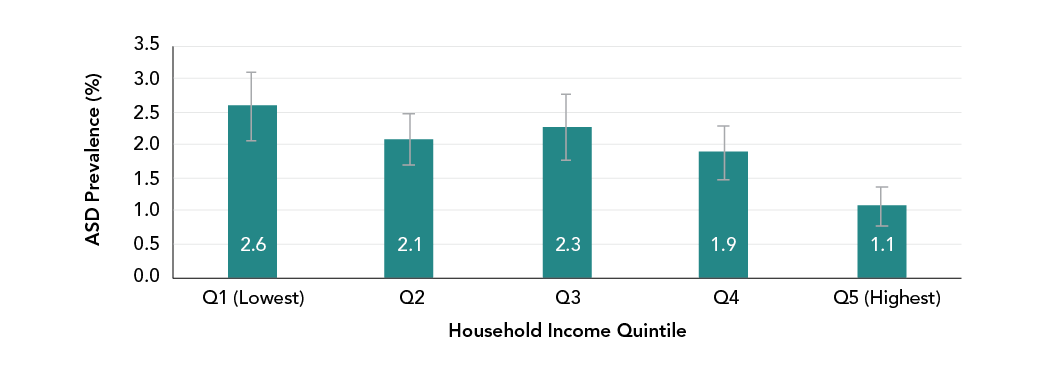
Notes: ASD = autism spectrum disorder. Q1 = quintile 1. Q2 = quintile 2. Q3 = quintile 3. Q4 = quintile 4. Q5 = quintile 5. The 95% confidence interval shows an estimated range of values that is likely to include the true prevalence 19 times out of 20.
Source: Public Health Agency of Canada, using data from the 2019 Canadian Health Survey on Children and Youth.
Figure 3 Text Description
| Household Income Quintile | ASD Prevalence, % [95% CI] |
|---|---|
| Q1 (Lowest) | 2.6 [2.1, 3.1] |
| Q2 | 2.1 [1.6, 2.5] |
| Q3 | 2.3 [1.9, 2.8] |
| Q4 | 1.9 [1.4, 2.4] |
| Q5 (Highest) | 1.1 [0.9, 1.4] |
Notes: ASD = autism spectrum disorder. Q1 = quintile 1. Q2 = quintile 2. Q3 = quintile 3. Q4 = quintile 4. Q5 = quintile 5. CI = confidence interval. The 95% confidence interval shows an estimated range of values that is likely to include the true prevalence 19 times out of 20. Source: Public Health Agency of Canada, using data from the 2019 Canadian Health Survey on Children and Youth. |
|
Prevalence by other sociodemographic factors
ASD prevalence was also explored by:
- population groupFootnote ‡ (visible minority, not a visible minority and indigenous identity)
- household education (less than high school, high school graduate and post-secondary graduate)
- location of residence (urban, rural)
However, no statistically significant differences among these categories were found.
Age at diagnosis
Just over half (53.7%) of children and youth were diagnosed with ASD before the age of five
Age at ASD diagnosis was determined from responses to the question: "How old was the child when first diagnosed with the following conditions? - Autism spectrum disorder, also known as autism, autistic disorder, Asperger's disorder or pervasive developmental disorder".Footnote 2
- Just over half (53.7% [48.5, 58.9]) of children and youth with ASD were diagnosed between the ages of 0 to 4, 40.3% [35.2, 45.4] between the ages of 5 to 11, and only 6.0%Footnote † [3.4, 8.6] between the ages of 12 to 17 (Figure 4). The differences between all three age groups were statistically significant.
Figure 4: Percentage of children and youth aged 1 to 17 years with ASD, by age at diagnosis, Canada, 2019

C High sampling variability (coefficient of variation between 15.0% and 25.0%).
Notes: ASD = autism spectrum disorder. The 95% confidence interval shows an estimated range of values that is likely to include the true prevalence 19 times out of 20.
Source: Public Health Agency of Canada, using data from the 2019 Canadian Health Survey on Children and Youth.
Figure 4 Text Description
| Age at Diagnosis (years) | Percentage, % [95% CI] |
|---|---|
| 0 to 4 | 53.7 [48.5, 58.9] |
| 5 to 11 | 40.3 [35.2, 45.4] |
| 12 to 17 | 6.0C [3.4, 8.6] |
C High sampling variability (coefficient of variation between 15.0% and 25.0%). Notes: ASD = autism spectrum disorder. CI = confidence interval. The 95% confidence interval shows an estimated range of values that is likely to include the true prevalence 19 times out of 20. Source: Public Health Agency of Canada, using data from the 2019 Canadian Health Survey on Children and Youth. |
|
Median age at diagnosis for ASD was 3.7 years
- Children and youth with ASD were diagnosed at a median age of 3.7 years [3.4, 4.1].
- Median age at diagnosis for ASD was statistically significantly different by population group, except for those who self-identified as indigenous.
- Visible minorities were diagnosed at a younger age (median age of 2.7 years [2.3, 3.1]), while those who identified as not a visible minority, were diagnosed at an older age (median age of 4.4 years [3.9, 5.0]).
- Median age at diagnosis did not statistically significantly differ by sex (male, female), household education (less than high school, high school graduate, post-secondary graduate), household income quintile (Q1 to Q5) or location of residence (urban, rural).
- Numerous factors may influence the age at diagnosis however, current evidence is conflicting or inconclusive.Footnote 7Footnote 8 Additional research is required to better understand this issue.
Life satisfaction, happiness and stress
Youth with ASD were less satisfied and happy with life but similar in levels of perceived stress compared to those without ASD
Life satisfaction was determined from responses to the question: "Using a scale of 0 to 10, how do you feel about your life as a whole right now?"Footnote 2 For the purposes of this report, responses were categorized as very dissatisfied/dissatisfied (0 to 4), neither satisfied nor dissatisfied (5), satisfied/very satisfied (6 to 10).
Self-perceived happiness was determined from responses to the question: "How would you usually describe yourself?"Footnote 2 For the purposes of this report, responses were categorized as "happy and interested in life", "somewhat happy", "somewhat unhappy", "unhappy with little interest in life"/"so unhappy that life is not worthwhile".
Self-perceived stress was determined from responses to the question: "Thinking about the amount of stress in your life, how would you describe most of your days?"Footnote 2 For the purposes of this report, responses were categorized as "not at all stressful"/"not very stressful", "a bit stressful", "quite a bit stressful"/"extremely stressful".
Among Canadians aged 12 to 17 years with ASD:
- statistically significantly fewer reported being "very satisfied" or "satisfied" with life (80.7% [73.8, 87.6]) than those without ASD (90.9% [90.2, 91.6]) (Figure 5)
- just under half (45.1% [36.1, 54.1]) reported that they were "happy and interested in life", compared to 64.7% [63.5, 65.8] of those without ASD, which was statistically significantly different
- no statistically significant differences were found in the stress levels reported by those with or without ASD
Figure 5: Life satisfaction, happiness and stress in youth aged 12 to 17 years with and without ASD, Canada, 2019
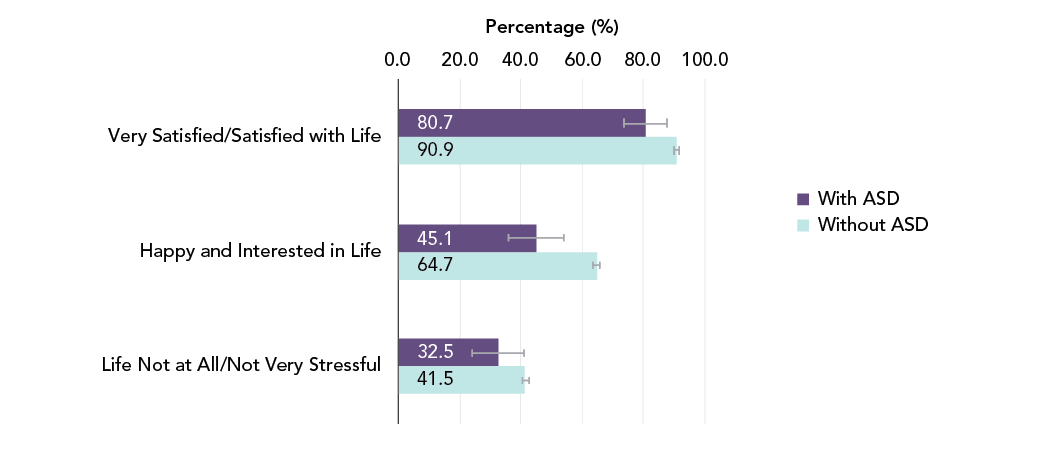
Notes: ASD = autism spectrum disorder. The 95% confidence interval shows an estimated range of values that is likely to include the true prevalence 19 times out of 20.
Source: Public Health Agency of Canada, using data from the 2019 Canadian Health Survey on Children and Youth.
Figure 5 Text Description
| Indicator Measure | With ASD, % [95% CI] | Without ASD, % [95% CI] |
|---|---|---|
| Very Satisfied/Satisfied with Life | 80.7 [73.8, 87.6] | 90.9 [90.2, 81.6] |
| Happy and Interested in Life | 45.1 [36.1, 54.1] | 64.7 [63.5, 65.8] |
| Life Not at All/Not Very Stressful | 32.5 [24.2, 40.8] | 41.5 [40.3, 42.7] |
Notes: ASD = autism spectrum disorder. CI = confidence interval. The 95% confidence interval shows an estimated range of values that is likely to include the true prevalence 19 times out of 20. Source: Public Health Agency of Canada, using data from the 2019 Canadian Health Survey on Children and Youth |
||
General and mental health
Children and youth with ASD had less optimal general and mental health compared to those without ASD
General and mental health status were determined from responses to the questions: "In general, how is this child's health?" and "In general, how is this child's mental health?"Footnote 2 For the purposes of this report, general health and mental health were categorized as "excellent"/"very good", "good", "fair"/"poor".
Among Canadians aged 1 to 17 years with ASD:
- less than two-thirds (59.3% [54.6, 64.1]) had "excellent" or "very good" general health, compared to 89.5% [89.0, 89.9] of those without ASD, which was statistically significantly different (Figure 6)
- slightly over a third had "excellent" or "very good" mental health (39.0% [34.0, 43.9]) compared to over three-quarters of those without ASD (84.1% [83.6, 84.7]), which was statistically significantly different
Figure 6: General health and mental health in children and youth aged 1 to 17 years with and without ASD, Canada, 2019
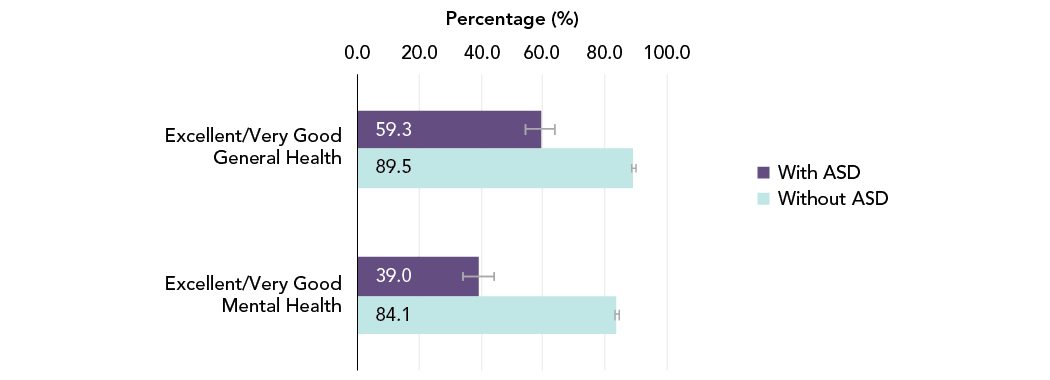
Notes: ASD = autism spectrum disorder. The 95% confidence interval shows an estimated range of values that is likely to include the true prevalence 19 times out of 20.
Source: Public Health Agency of Canada, using data from the 2019 Canadian Health Survey on Children and Youth.
Figure 6 Text Description
| Indicator Measure | With ASD, % [95% CI] | Without ASD, % [95% CI] |
|---|---|---|
| Excellent/Very Good General Health | 59.3 [54.6, 64.1] | 89.5 [89.0, 89.9] |
| Excellent/Very Good Mental Health | 39.0 [34.0, 43.9] | 84.1 [83.6, 84.7] |
Notes: ASD = autism spectrum disorder. CI = confidence interval. The 95% confidence interval shows an estimated range of values that is likely to include the true prevalence 19 times out of 20. Source: Public Health Agency of Canada, using data from the 2019 Canadian Health Survey on Children and Youth |
||
Co-occurring long-term health conditions
Children and youth with ASD were three times more likely to have another long-term health condition compared to those without ASD
Children and youth were identified as having a long-term health condition if their PMK responded "yes" to the question: "Has this child been diagnosed with any of the following long-term conditions?" for each of the specified conditions.Footnote 2 Conditions included: asthma, diabetes, epilepsy, an anxiety disorder (such as a phobia, obsessive-compulsive disorder, or a panic disorder), a mood disorder (such as depression, bipolar disorder, mania, or dysthymia), an eating disorder (such as anorexia nervosa or bulimia), a learning disability or disorder, attention deficit disorder/attention deficit hyperactivity disorder (ADD/ADHD), fetal alcohol spectrum disorder and other unspecified conditions. Several conditions (learning disability/disorder, anxiety disorder, mood disorder and eating disorder) were only asked to the PMK of children and youth aged 5 to 17 years, while the rest were asked to the PMK of all children and youth (aged 1 to 17 years).
For the purposes of this report, children and youth who were identified as having at least one of these conditions were classified as having another long-term health condition. The specific long-term health conditions were separated into two groups based on the age groups for which the question was asked (1 to 17 years or 5 to 17 years). Children and youth with ASD were compared to children and youth without ASD, in terms of the proportion with long-term health conditions.
Over two thirds (68.7% [64.4, 73.1]) of children and youth with ASD had another long-term health condition, compared to 21.9% [21.3, 22.5] of those without ASD (Figure 7). This difference was statistically significant.
Figure 7: Percentage of children and youth aged 1 to 17 years with and without ASD that have another long-term health condition, Canada, 2019
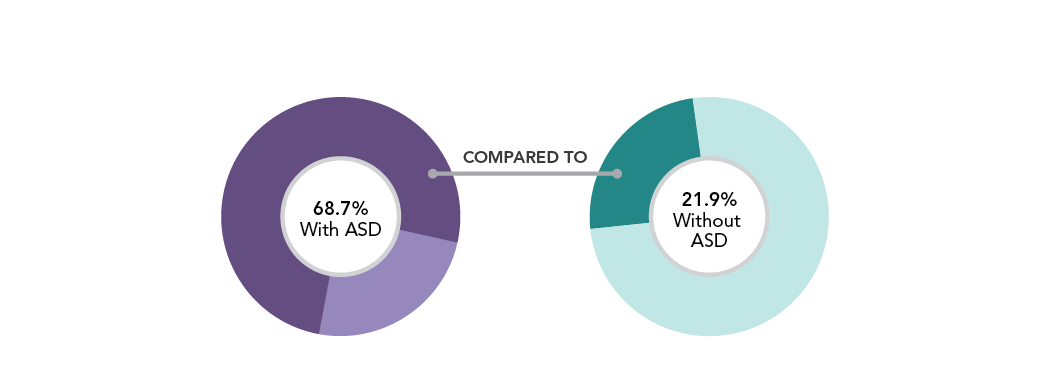
Notes: ASD = autism spectrum disorder.
Source: Public Health Agency of Canada, using data from the 2019 Canadian Health Survey on Children and Youth.
Figure 7 Text Description
This figure compares the percentage of children and youth aged 1 to 17 with and without ASD that have another long-term health condition. Findings demonstrate 68.7% of those with ASD had another long-term health condition, compared to 21.9% of those without ASD.
Of these long-term health conditions, ADD/ADHD, learning disability/disorder and anxiety disorder were among the most commonly diagnosed long-term health conditions in children and youth with ASD.
- ADD/ADHD (36.5% [32.0, 41.1]) was the most common co-occurring long-term health condition among children and youth aged 1 to 17 years with ASD (Figure 8).
- Learning disability/disorder (48.1% [42.8, 53.4]) and anxiety disorder (22.1% [18.1, 27.0]) were the most common co-occurring conditions in those aged 5 to 17 years with ASD (Figure 9).
- About one fifth (19.9% [16.1, 23.8]) of children and youth with ASD aged 1 to 17 years had other long-term health conditions; however, respondents were not asked to specify what these conditions were.
- The proportion of children and youth with ASD that had each of these long-term health conditions was statistically significantly greater than those without ASD.
Figure 8: Percentage of children and youth aged 1 to 17 years with and without ASD, who have specific long-term health conditions, Canada, 2019
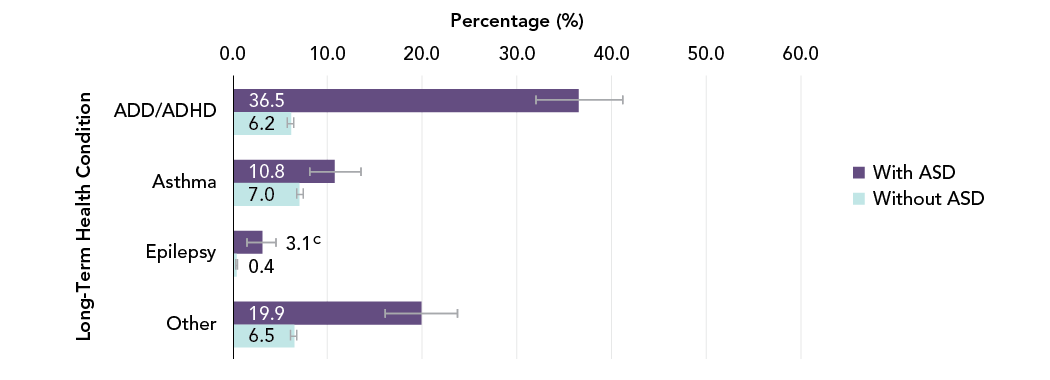
C High sampling variability (coefficient of variation between 15.0% and 25.0%).
Notes: ASD = autism spectrum disorder. ADD/ADHD = attention deficit disorder/attention deficit hyperactivity disorder. The 95% confidence interval shows an estimated range of values that is likely to include the true prevalence 19 times out of 20. The percentage of children and youth with diabetes or fetal alcohol spectrum disorder could not be reported due to high sampling variability in those with ASD.
Source: Public Health Agency of Canada, using data from the 2019 Canadian Health Survey on Children and Youth.
Figure 8 Text Description
| Long-Term Health Condition | With ASD, % [95% CI] | Without ASD, % [95% CI] |
|---|---|---|
| ADD/ADHD | 36.5 [32.0, 41.1] | 6.2 [5.8, 6.5] |
| Asthma | 10.8 [8.1, 13.6] | 7.0 [6.7, 7.4] |
| Epilepsy | 3.1C [1.6, 4.6] | 0.4 [0.3, 0.5] |
| Other | 19.9 [16.1, 23.8] | 6.5 [6.1, 6.8] |
C High sampling variability (coefficient of variation between 15.0% and 25.0%). Notes: ASD = autism spectrum disorder. ADD/ADHD = attention deficit disorder/attention deficit hyperactivity disorder. CI = confidence interval. The 95% confidence interval shows an estimated range of values that is likely to include the true prevalence 19 times out of 20. The percentage of children and youth with diabetes or fetal alcohol spectrum disorder could not be reported due to high sampling variability in those with ASD. Source: Public Health Agency of Canada, using data from the 2019 Canadian Health Survey on Children and Youth. |
||
Figure 9: Percentage of children and youth aged 5 to 17 years with and without ASD, who have specific long-term health conditions, Canada, 2019
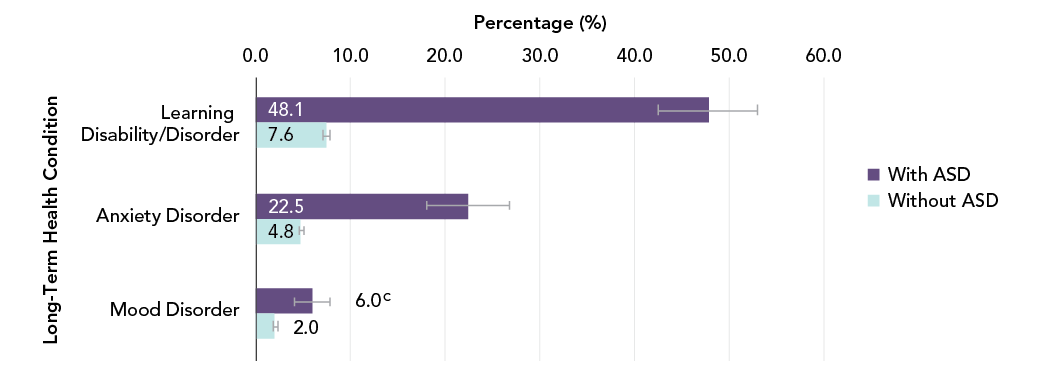
C High sampling variability (coefficient of variation between 15.0% and 25.0%).
Notes: ASD = autism spectrum disorder. The 95% confidence interval shows an estimated range of values that is likely to include the true prevalence 19 times out of 20. The percentage of children and youth with an eating disorder could not be reported due to high sampling variability in those with ASD.
Source: Public Health Agency of Canada, using data from the 2019 Canadian Health Survey on Children and Youth.
Figure 9 Text Description
| Long-Term Health Condition | With ASD, % [95% CI] | Without ASD, % [95% CI] |
|---|---|---|
| Learning Disability/Disorder | 48.1 [42.8, 53.4] | 7.6 [7.1, 8.0] |
| Anxiety Disorder | 22.5 [18.1, 27.0] | 4.8 [4.5, 5.2] |
| Mood Disorder | 6.0C [4.0, 7.9] | 2.0 [1.8, 2.3] |
C High sampling variability (coefficient of variation between 15.0% and 25.0%). Notes: ASD = autism spectrum disorder. CI = confidence interval. The 95% confidence interval shows an estimated range of values that is likely to include the true prevalence 19 times out of 20. The percentage of children and youth with an eating disorder could not be reported due to high sampling variability in those with ASD. Source: Public Health Agency of Canada, using data from the 2019 Canadian Health Survey on Children and Youth. |
||
Functional difficulties
Close to three-quarters of children and youth with ASD had difficulty in at least one functional domain
Functional difficulties were captured using the Washington Group/United Nations Children's Fund Child Functioning Module (2016).Footnote 9 This module was designed to assess difficulties in various functional domains in children and youth aged 2 to 17 years. For example, children and youth were identified as having difficulty accepting change if their PMK selected "A lot of difficulty" or "Cannot do at all" to the question: "Does this child have difficulty accepting changes in their routine?"Footnote 2
For the purposes of this report, difficulties by functional domain were reported by age group (2 to 4, 5 to 11 and 12 to 17 years) in order to examine functional difficulties across the developmental period.
The functional domains assessed differed by age group and were as follows:
- Children aged 2 to 4 years: communication, controlling behaviour, fine motor skills, hearing, learning, playing, seeing and walking
- Children aged 5 to 11 years: accepting change, anxiety, communication, concentrating, controlling behaviour, depression, hearing, learning, making friends, remembering, seeing, self-care and walking
- Youth aged 12 to 17 years: accepting change, anxiety, communication, concentrating, controlling behaviour, depression, hearing, learning, making friends, remembering, seeing, self-care and walking
Children and youth with ASD were compared to children without ASD, in terms of proportion with functional difficulties.
Nearly three-quarters (73.3% [69.1, 77.5]) of children and youth aged 2 to 17 years with ASD had difficulty in at least one functional domain, which is statistically significantly greater than those without ASD (10.1% [9.7, 10.6]) (Figure 10).
Figure 10: Percentage of children and youth aged 2 to 17 years with and without ASD that have difficulty in at least one functional domain, Canada, 2019

Notes: ASD = autism spectrum disorder.
Source: Public Health Agency of Canada, using data from the 2019 Canadian Health Survey on Children and Youth.
Figure 10 Text Description
This figure compares the percentage of children and youth aged 2 to 17 with and without ASD that have difficulty in at least one functional domain. Findings demonstrate 73.3% of those with ASD had difficulty in at least one functional domain, compared to 10.1% of those without ASD.
- Of those with ASD aged 2 to 4 years (Figure 11):
- 52.5% [41.8, 63.3] had difficulty with communication
- 37.8% [27.8, 47.9] had difficulty learning
- 25.0%Footnote † [16.6, 33.4] had difficulty playing
- Among those with ASD aged 5 to 11 years (Figure 12), the most common functional difficulties were:
- accepting change (46.8% [40.2, 53.5])
- making friends (44.9% [38.2, 51.6])
- learning (37.5% [30.7, 44.3])
- controlling behaviour (36.5% [30.0, 43.0])
- anxiety (32.1% [25.5, 38.6])
- communication (28.2% [22.0, 34.3])
- For youth aged 12 to 17 years with ASD (Figure 13), the most common functional difficulties were:
- making friends (48.2% [39.2, 57.3])
- accepting change (35.8% [27.2, 44.4])
- learning (25.7%Footnote † [18.0, 33.4])
- The proportion of children and youth with ASD who had difficulty in each functional domain was statistically significantly greater than those without ASD, with the exception of depression in those aged 12 to 17 which was not statistically significantly different.
Figure 11: Percentage of children aged 2 to 4 years with and without ASD with difficulty in specific functional domains, Canada, 2019
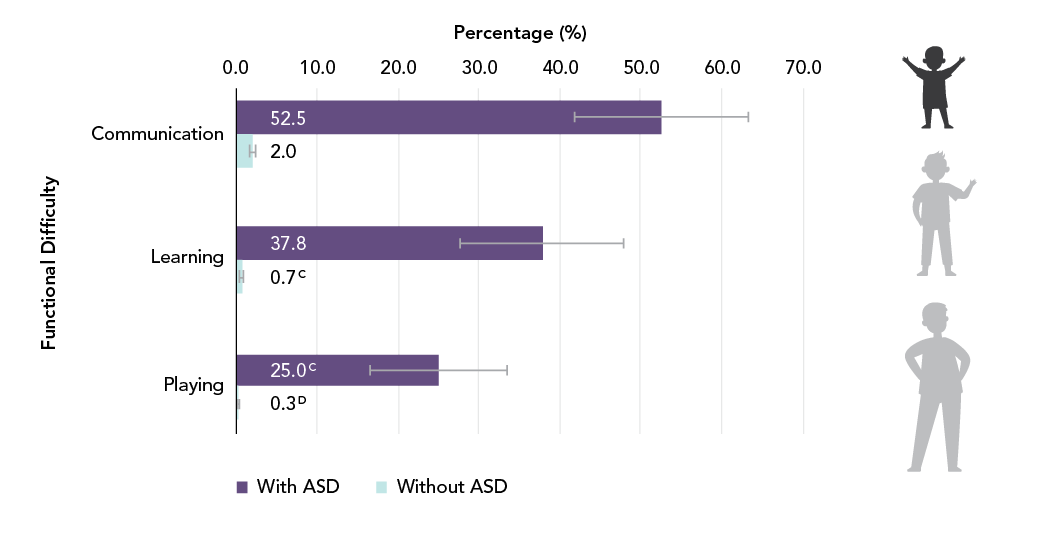
C High sampling variability (coefficient of variation between 15.0% and 25.0%).
D High sampling variability (coefficient of variation between 25.0% and 35.0%).
Notes: ASD = autism spectrum disorder. The 95% confidence interval shows an estimated range of values that is likely to include the true prevalence 19 times out of 20. The percentage of children with difficulty with controlling behaviour, fine motor skills, hearing, seeing and walking could not be reported due to high sampling variability in those with ASD.
Source: Public Health Agency of Canada, using data from the 2019 Canadian Health Survey on Children and Youth.
Figure 11 Text Description
| Functional Difficulty | With ASD, % [95% CI] | Without ASD, % [95% CI] |
|---|---|---|
| Communication | 52.5 [41.8, 63.3] | 2.0 [1.6, 2.4] |
| Learning | 37.8 [27.8, 47.9] | 0.7 C [0.4, 0.9] |
| Playing | 25.0C [16.6, 33.4] | 0.3D [0.1, 0.5] |
C High sampling variability (coefficient of variation between 15.0% and 25.0%). D High sampling variability (coefficient of variation between 25.0% and 35.0%). Notes: ASD = autism spectrum disorder. CI = confidence interval. The 95% confidence interval shows an estimated range of values that is likely to include the true prevalence 19 times out of 20. The percentage of children with difficulty with controlling behaviour, fine motor skills, hearing, seeing and walking could not be reported due to high sampling variability in those with ASD. Source: Public Health Agency of Canada, using data from the 2019 Canadian Health Survey on Children and Youth. |
||
Figure 12: Percentage of children aged 5 to 11 years with and without ASD with difficulty in specific functional domains, Canada, 2019
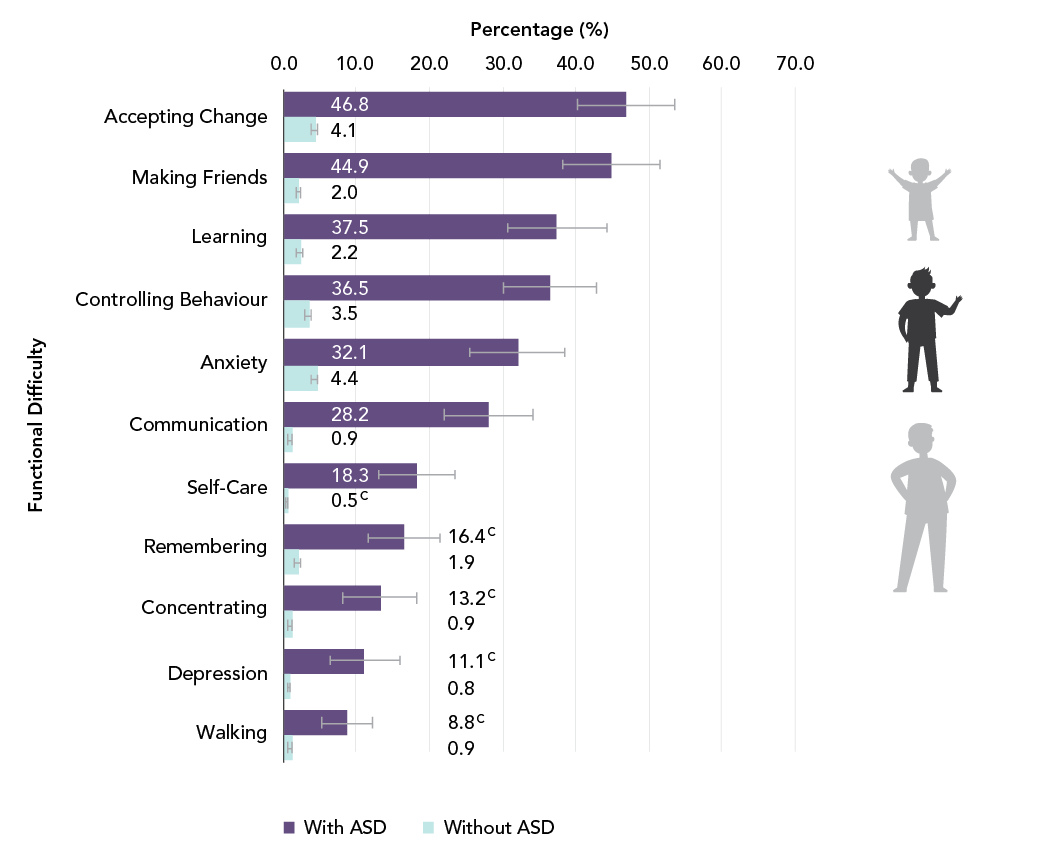
C High sampling variability (coefficient of variation between 15.0% and 25.0%).
Notes: ASD = autism spectrum disorder. The 95% confidence interval shows an estimated range of values that is likely to include the true prevalence 19 times out of 20. The percentage of children with difficulty with hearing and seeing could not be reported due to high sampling variability in those with ASD.
Source: Public Health Agency of Canada, using data from the 2019 Canadian Health Survey on Children and Youth.
Figure 12 Text Description
| Functional Difficulty | With ASD, % [95% CI] | Without ASD, % [95% CI] |
|---|---|---|
| Accepting Change | 46.8 [40.2, 53.5] | 4.1 [3.7, 4.6] |
| Making Friends | 44.9 [38.2, 51.6] | 2.0 [1.7, 2.3] |
| Learning | 37.5 [30.7, 44.3] | 2.2 [1.9, 2.6] |
| Controlling Behaviour | 36.5 [30.0, 43.0] | 3.5 [3.0, 3.9] |
| Anxiety | 32.1 [25.5, 38.6] | 4.4 [3.9, 4.8] |
| Communication | 28.2 [22.0, 34.3] | 0.9 [0.7, 1.1] |
| Self-Care | 18.3 [13.1, 23.5] | 0.5C [0.4, 0.7] |
| Remembering | 16.4C [11.5, 21.4] | 1.9 [1.6, 2.2] |
| Concentrating | 13.2C [8.2, 18.3] | 0.9 [0.7, 1.1] |
| Depression | 11.1C [6.3, 15.9] | 0.8 [0.6, 1.0] |
| Walking | 8.8C [5.3, 12.3] | 0.9 [0.7, 1.1] |
C High sampling variability (coefficient of variation between 15.0% and 25.0%). Notes: ASD = autism spectrum disorder. CI = confidence interval. The 95% confidence interval shows an estimated range of values that is likely to include the true prevalence 19 times out of 20. The percentage of children with difficulty with hearing and seeing could not be reported due to high sampling variability in those with ASD. Source: Public Health Agency of Canada, using data from the 2019 Canadian Health Survey on Children and Youth. |
||
Figure 13: Percentage of youth aged 12 to 17 years with and without ASD with difficulty in specific functional domains, Canada, 2019
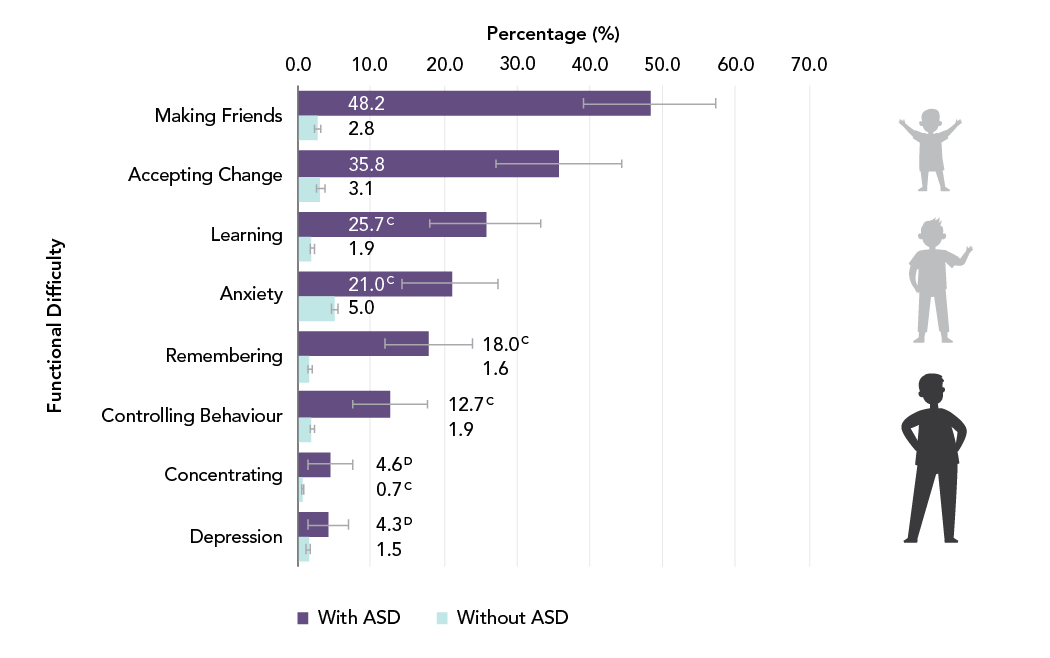
C High sampling variability (coefficient of variation between 15.0% and 25.0%).
D High sampling variability (coefficient of variation between 25.0% and 35.0%).
Notes: ASD = autism spectrum disorder. The 95% confidence interval shows an estimated range of values that is likely to include the true prevalence 19 times out of 20. The percentage of youth with difficulty with communication, self-care, walking, hearing and seeing could not be reported due to high sampling variability in those with ASD.
Source: Public Health Agency of Canada, using data from the 2019 Canadian Health Survey on Children and Youth.
Figure 13 Text Description
| Functional Difficulty | With ASD, % [95% CI] | Without ASD, % [95% CI] |
|---|---|---|
| Making Friends | 48.2 [39.2, 57.3] | 2.8 [2.4, 3.2] |
| Accepting Change | 35.8 [27.2, 44.4] | 3.1 [2.7, 3.6] |
| Learning | 25.7C [18.0, 33.4] | 1.9 [1.6, 2.3] |
| Anxiety | 21.0C [14.5, 27.6] | 5.0 [4.5, 5.5] |
| Remembering | 18.0C [12.0, 24.0] | 1.6 [1.3, 1.9] |
| Controlling Behaviour | 12.7C [7.5, 18.0] | 1.9 [1.6, 2.3] |
| Concentrating | 4.6D [1.6, 7.7] | 0.7 C [0.4, 0.9] |
| Depression | 4.3D [1.6, 7.1] | 1.5 [1.2, 1.7] |
C High sampling variability (coefficient of variation between 15.0% and 25.0%). D High sampling variability (coefficient of variation between 25.0% and 35.0%). Notes: ASD = autism spectrum disorder. CI = confidence interval. The 95% confidence interval shows an estimated range of values that is likely to include the true prevalence 19 times out of 20. The percentage of youth with difficulty with communication, self-care, walking, hearing and seeing could not be reported due to high sampling variability in those with ASD. Source: Public Health Agency of Canada, using data from the 2019 Canadian Health Survey on Children and Youth. |
||
School experiences
More than three-quarters (78.1%) of school-aged children and youth with ASD had special education needs
School enrollment was determined if the PMK or youth (aged 12 to 17 years) responded "yes" to the question: "[Is this child/Are you] currently enrolled in school?"Footnote 2
Children and youth were identified as having special education needs if the PMK or youth (aged 12 to 17 years) responded "yes" to the question: "At [their/your] school, [do they/do you personally] have an Individual Education Plan (IEP), Special Education Plan (SEP) or Inclusion and Intervention Plan (IIP)?"Footnote 2
The reason for having an IEP/SEP/IIP was determined from responses to the question: "Which of the following learning exceptionalities or special education needs is [their/your] IEP, SEP or IIP for?"Footnote 2 The PMK or youth (aged 12 to 17 years) could select multiple responses including: a permanent physical disability, a cognitive, behavioural or emotional disability, gifted or other.
- The vast majority (91.7% [89.2, 94.2]) of those with ASD aged 3 years and older were enrolled in school at the time of the survey. This was not statistically significantly different from those without ASD (89.8% [89.5, 90.2]).
- Of those with ASD who were enrolled in school:
- more than three-quarters (78.1% [73.4, 82.7]) had an IEP, SEP or IIP, compared to just 13.4% [12.8, 13.9] of those without ASD, which was statistically significantly different
- most (93.7% [90.7, 96.6]) of those who had an IEP, SEP or IIP, had it due to a cognitive, behavioural or emotional disability (Figure 14)
Figure 14: Percentage of children and youth aged 3 to 17 years with ASD who have an IEP/SEP/IIP by reason, Canada, 2019
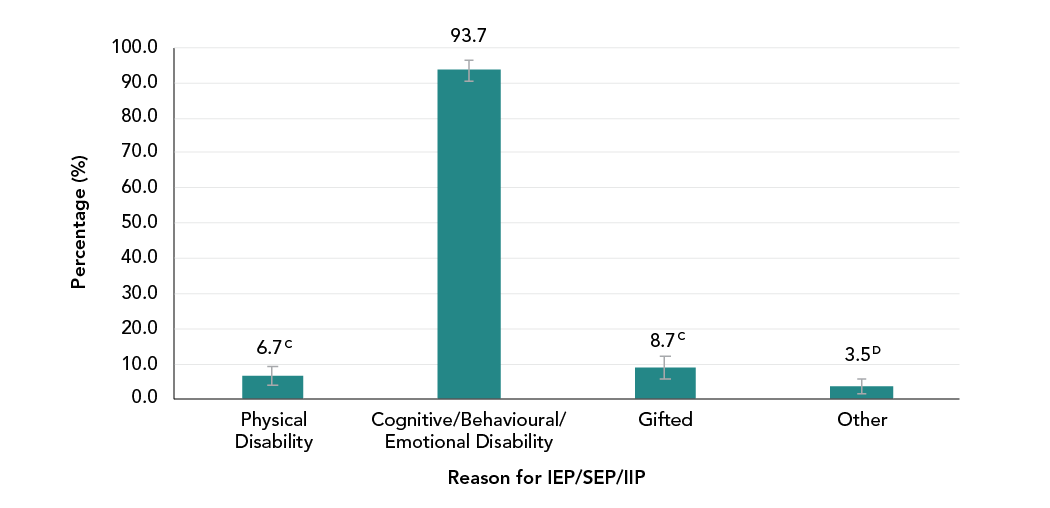
C High sampling variability (coefficient of variation between 15.0% and 25.0%).
D High sampling variability (coefficient of variation between 25.0% and 35.0%).
Notes: ASD = autism spectrum disorder. IEP = Individual Education Plan. SEP = Special Education Plan. IIP = Inclusion and Intervention Plan. The 95% confidence interval shows an estimated range of values that is likely to include the true prevalence 19 times out of 20. Percentages add to more than 100% because individuals could report multiple reasons for an IEP/SEP/IIP.
Source: Public Health Agency of Canada, using data from the 2019 Canadian Health Survey on Children and Youth.
Figure 14 Text Description
| Reason for IEP/SEP/IIP | Percentage, % [95% CI] |
|---|---|
| Physical Disability | 6.7C [4.0, 9.5] |
| Cognitive/Behavioural/Emotional Disability | 93.7 [90.7, 96.6] |
| Gifted | 8.7C [5.4, 11.9] |
| Other | 3.5D [1.4, 5.6] |
C High sampling variability (coefficient of variation between 15.0% and 25.0%). D High sampling variability (coefficient of variation between 25.0% and 35.0%). Notes: ASD = autism spectrum disorder. IEP = Individual Education Plan. SEP = Special Education Plan. IIP = Inclusion and Intervention Plan. CI = confidence interval. The 95% confidence interval shows an estimated range of values that is likely to include the true prevalence 19 times out of 20. Percentages add to more than 100% because individuals could report multiple reasons for an IEP/SEP/IIP. Source: Public Health Agency of Canada, using data from the 2019 Canadian Health Survey on Children and Youth. |
|
Closing remarks
This report represents the first analysis of Canadian children and youth with ASD using national survey data. According to the 2019 CHSCY, 2.0% of children and youth aged 1 to 17 years living in private dwellings in the ten provinces and three territories were diagnosed with ASD. These individuals were predominately male and close to half were not diagnosed until after the age of five. Compared to those without ASD, children and youth with ASD were less likely to report optimal general or mental health, more likely to have other long-term health conditions such as ADD/ADHD, learning disabilities/disorders and anxiety disorders and more likely to report difficulty in functional domains including communication, accepting change and making friends. However, evidence suggests that early diagnosis of ASD and early access to behavioural and educational interventions can improve long-term outcomes.Footnote 10
The 2019 CHSCY collected a wide range of health related information and provides a unique opportunity to broaden our understanding of the health and well-being of Canadian children and youth with ASD. The findings presented within this report will help build the evidence base required to inform public health action to help Canadians with ASD and their caregivers. Future cycles of this survey will allow for further reporting on this population and the examination of trends over time.
Resources
For information, tools and resources aimed to support those with ASD and their caregivers visit:
- AideCanada
- Autism Canada
- Canadian Autism Spectrum Disorders Alliance
- Canadian Pediatric Society: Autism Spectrum Disorder
- Government of Canada: Autism Spectrum Disorder
COVID-19 statement
COVID-19 has brought unprecedented changes to Canadians. Data from the 2019 CHSCY were collected prior to the COVID-19 pandemic. The information presented within this report reflect the experiences and challenges of Canadian children and youth with ASD at the time of data collection. The pandemic may have exacerbated the challenges faced by an already vulnerable population. For additional information visit COVID-19 and people with disabilities in Canada.
About the data
Data source
Data used in this report are from the 2019 Canadian Health Survey on Children and Youth (CHSCY). The CHSCY is a national, cross-sectional survey that collected health related information on children and youth aged 1 to 17 years as of January 31 2019, living in private dwellings in Canada's ten provinces and three territories (response rate 52.1%).Footnote 11Footnote 12 The full unweighted sample size was 39,951, with 819 children and youth identified as having diagnosed ASD. Excluded from the survey were children and youth living on First Nation reserves and other Aboriginal settlements in the provinces, children and youth living in foster homes and in institutions. All data presented were collected via self-reported questionnaire administrated to the PMK about the selected child/youth with the exception of the data on life satisfaction, happiness and stress, which were directly reported by youth aged 12 to 17 years. Data on school enrollment and special education were reported by the PMK for children aged 3 to 11 years and directly by youth aged 12 to 17 years. More information about the 2019 CHSCY can be found on Statistics Canada's website.
Statistical methods
All estimates were weighted to be representative of the Canadian population age 1 to 17 and the bootstrap method was used to calculate variance estimates, including 95% confidence intervals and coefficients of variation. To determine whether differences between two independent estimates were statistically significant or not, the associated 95% confidence intervals were compared. Non-overlapping 95% confidence intervals between estimates were considered statistically significantly different. ASD prevalence estimates for the provinces/territories were age-standardized in order to control for differences in the age distributions between the provinces/territories. Age-standardization was done using the 2011 Canadian Census population, which is the current standard population used.
Limitations
Findings within this report should be interpreted in light of:
- reliance on self-reporting of health-related events with no third-party corroboration or verification of these self-reports
- limited generalizability of the findings to the entire Canadian population aged 1 to 17 years due to the exclusion of some specific subpopulations
- analytical limitations due to the available sample size when disaggregating data by specific characteristics of interest
Definition of terms
- Age-standardized Prevalence:
- A summary measure of the prevalence that a study population would have if it had the same age structure as the standard population. Age-standardized prevalence is commonly used when comparing estimates over time (trend analysis) or when comparing estimates from different geographical areas or subpopulations.
- Coefficient of Variation:
- A statistical measurement of the reliability of an estimate in regard to the sampling variability. The coefficient of variation provides a relative measure of the sampling error as a proportion of the estimate. Coefficients of variation will increase as the variability of an estimate increases, and decrease as an estimate is more precise.
- Confidence Interval:
- A statistical measurement of the reliability of an estimate. The size of the confidence interval relates to the precision of the estimate with narrow confidence intervals indicating greater precision than those that are wide. The 95% confidence interval shows an estimated range of values that is likely to include the true value 19 times out of 20.
- Crude Prevalence:
- Prevalence determined by dividing the total number of cases in a given time period by the total number of persons in the population.
- Median:
- The value that falls in the middle of the distribution of values for a given variable. For example, the median age at diagnosis for ASD in this report represents the age that falls in the middle of the values for age at diagnosis among children and youth with ASD.
- Prevalence:
- The frequency of a disease or condition in a population during a defined period of time, represented as a proportion of that population. Prevalence is often expressed as a percentage, or as the number of cases per 1,000 or 100,000 individuals in the population.
Acknowledgements
The Public Health Agency of Canada wishes to acknowledge and thank the following individuals for their contributions to this report:
Public Health Agency of Canada contributors:
- Sarah Palmeter
- Siobhan O'Donnell
- Claudia Lagacé
- Mihaela Gheorghe
- Matthew Krupovich
External contributors:
- Jonathan Lai, Executive Director, Canadian Autism Spectrum Disorders Alliance
- Rakhee Chowdhury, Communications Manager, Canadian Autism Spectrum Disorders Alliance
- Jill Farber, Executive Director, Autism Speaks Canada
- Jessica Brian, Co-Lead of the Autism Research Centre, Holland Bloorview Kids Rehabilitation Hospital
- Lonnie Zwaigenbaum, Department of Pediatrics, University of Alberta